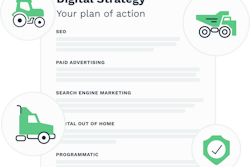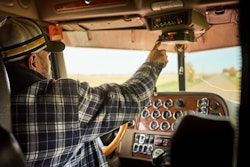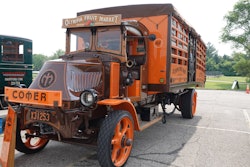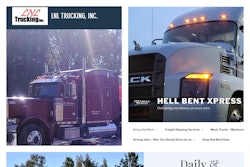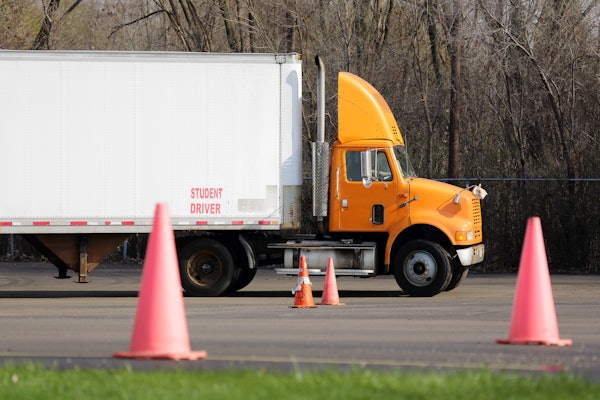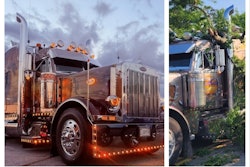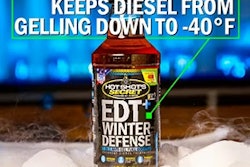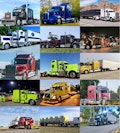Off the top of this week's Overdrive Radio podcast is the voice of photojournalist James Year, commenting on an issue he feels holds potential to create alliances where few have existed in American culture and commentary.
"In every market you can think of, there's a lot of disruptions starting to happen," Year said, "and it's one of those cases of strange bedfellows. ... Turns out truckers and actors and all the people that are generally fighting like hell with each other ... turns out they've got a lot in common on this topic."
Namely, he’s talking about automation, artificial intelligence, the import technology holds for work opportunity in a variety of fields. In trucking, where that’s perhaps most salient -- certainly grabbing the most headlines -- is in the operating of the trucks themselves. The jumping-off point for the podcast is Year's recent short documentary video published via the More Perfect Union video channels. It came with an ominous title, and a video cover image clearly designed to raise a safety specter with respect to unmanned trucks on public roads.
 This was the cover image for the video release, overlaying the picture of the young woman holding a child to make it look like they could be be run over, essentially, by the Peterbilt here outfitted with the Aurora Innovations company’s Driver system.Screengrab of James Year's More Perfect Union doc video | StealingFire.tech/more-perfect-union-documentary
This was the cover image for the video release, overlaying the picture of the young woman holding a child to make it look like they could be be run over, essentially, by the Peterbilt here outfitted with the Aurora Innovations company’s Driver system.Screengrab of James Year's More Perfect Union doc video | StealingFire.tech/more-perfect-union-documentary

The headline? More safety-scare tactics: We chased driverless trucks in Texas. What we saw will scare you.
Year said he deferred to platform publishers and producers, generally, on pitching the vid to its general-public audience, and "probably wouldn't have chosen that title." There’s no scary crash in the video. There’s not even an unmanned, truly “driverless” truck in it.
Rather Year, with truck driver Will Cook in the passenger seat of a car, followed an Aurora Driver-outfitted truck that to start the trip actually had two operators in-cab late in April. Yet the pitch worked, clearly -- since release three weeks ago the 15-minute video has been viewed nearly 2 million times, according to the Youtube counter. It all followed Year's long photojournalism project for his master’s work at Syracuse University. Year now teaches photography in Maryland.
 James Year
James Year
Whose human error? As any trucker familiar with crash causation stats that exist well knows, the majority of that 85% weren't caused by the error of the professional truck operator.
[Related: How far could the crash-liability chain for automated vehicles extend?]
The text block continues. “From 2021 to 2023, large truck crashes led to more than 15,000 deaths in the U.S.” Again, deaths caused by the error of whom?
Year’s work is ultimately less focused on automated-truck safety than employment and work prospects for the untold thousands of owner-operators and company drivers in trucking today. The often disputed and debunked “driver shortage” narrative and how it plays into the sales pitch for automation is detailed, likewise the history of deregulation and the intense competition that resulted from the 1980s onward, both tales Overdrive readers will be largely familiar with.
Year and video subjects assume autonomous tech companies will ultimately succeed, allowing fleets to achieve real cost savings in safely removing the driver from the cab working on a large number of lanes. If so, what happens to all the individuals who might have otherwise done that work?
It's a question that’ll make you think, no doubt, and we’ve posed it before. Some of the tech companies we’ve interrogated about it no longer in fact exist, having imploded after investment cash dried up or they made a mistake of one kind or another and spooked whatever investors they did have. Still existing tech companies like Aurora and Plus.ai, among others working on robotruck technology, tend all to stick to the notion that if you’re driving today, you’ll be able to retire as a truck driver even as automated driving tech improves.
[Related: 'Big Beautiful Bill' AI provisions could halt state driverless bans]
To wit, Earl Adams Jr., formerly with the Federal Motor Carrier Safety Administration and now Vice President of Public Policy and Regulatory Affairs for the Plus.ai company: "If a man or woman wants to be a long-haul truck driver, and starts today, they will be able to retire as a long-haul truck driver," he said. Even with deployment of automated systems, he added, "we don’t see it as a full replacement for truck drivers -- we’re supplementing the driving pool."
Debates over the reality of any "driver shortage" notwithstanding, acknowledged by Adams, "we know [the driver pool] is dwindling, it’s getting smaller," he contended. "The pool of people interested in getting a CDL is getting smaller, but the demand for goods is increasing."
[Related: New research takes aim at 'driver shortage' narrative, traces roots to 1980s deregulation]
Given fleets' clear interest in helping develop these systems, for owner-operators maybe the better question is when will owners have to compete with them at scale?
I don’t have a great answer after reporting this story, but what I can tell you is that the time is probably not exactly right now, as it were. The Atlas Energy company’s work with the Kodiak Robotics self-driving system has a grand total of four fully unmanned trucks operating on private oilfield lease roads in the Permian Basin, according to sources with knowledge of the operation, all requiring a lot of outside support at load and unload and in between, besides. Everybody else utilizing these systems on public roads appears to be still running them with someone, at least, somewhere in the cab.
Though the company didn't directly answer the question of how many truly unmanned vehicles they have on the road today, the Aurora Innovations trucking operation I’d include in that, despite their May 1 commercial launch of “driverless” trucking service on I-45 between Houston and Dallas for Uber Freight and Hirschbach Motor Lines. A short time after the launch, the company noted Paccar had objected to any of their trucks outfitted with the Aurora Driver being operated without a driver at the ready. The company said it would move its “observer” back into the front seat -- from the rear of the vehicle, where they'd been on "some of our trips."
An Aurora representative asked about that move insisted the company’s Aurora Driver technology involved in the commercial launch remained fully responsible for piloting the line-haul portion of those runs, and made a distinction between the “observer” terminology and more typical “safety driver” phrase describing an operator at the controls as a failsafe. Yet it’s probably safe to presume those “observers” aren’t working for free.
Paccar representatives declined an opportunity to comment, as did one among Aurora's freight partners in its commercial launch, Uber Freight. Hirschbach Motor Lines did not respond to my inquiries, either.
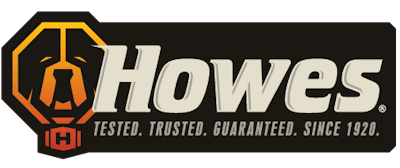 Overdrive Radio's sponsor is Howes, longtime provider of fuel treatments like its Howes Diesel Defender all-weather mileage booster and winter anti-gel treatments to get you through the coldest temps, the Howes Multipurpose penetrating oil, and other products.
Overdrive Radio's sponsor is Howes, longtime provider of fuel treatments like its Howes Diesel Defender all-weather mileage booster and winter anti-gel treatments to get you through the coldest temps, the Howes Multipurpose penetrating oil, and other products.
As Monkmeyer had it, “we in fact need more locally based drivers to do the first and last mile, allowing them to do multiple runs in a day and handle the more complex aspects of the route while returning home every night. Additionally, more drivers will be needed to support the AV hubs, undertaking tasks such as enhanced pre-trip planning, security checks” and other tasks.
Plus.ai for its part isn’t at any kind of driver-out stage with its work with the Traton Group -- in North America that’s mostly the International Trucks brand for Class 8s. Adams noted that all of its “driver out” testing was being done on closed courses to date.
Has an autonomous truck taken a driver’s job as yet? Maybe a few out in the Texas oilfield, as it were, yet not in meaningful numbers to date, to say nothing of additional support personnel needed for any AV truck. Yet the language Jim Monkmeyer used to describe DHL’s relationship with Volvo Autonomous Solutions’ freight service with automated vehicles suggested that maybe owner-operators are in fact competing with AV trucking companies already, in some form. Monkmeyer described that relationship as DHL leasing capacity from the Volvo group on the hub-to-hub linehaul routes. Maybe we can think of Volvo and Aurora’s place in the trucking marketplace like that of an owner-operator leased to a larger entity.
If the analogy holds, well, perhaps owner-ops are competing with the tech trucking companies already. Stay lean on costs, and you’re probably poised to win that battle at present, though all could change if “driver out” ever hits in a big way.
Photojournalist James Year certainly feels that human-tech competition is only set to grow in the coming years, and the need for more conversation about safety, business, and labor implications has never been greater.
What do you think? Weigh in via our two-question survey below, and hear more reporting about the subject in this week's podcast:
[Related: 'Venture capital is a little fickle': Starsky Robotics lays off all drivers and closes up shop]


